Unveiling the Timeless Meanings: 12 Essential Christmas Ornaments and Their Symbolism
The holiday season is a magical time, filled with warmth, joy, and cherished traditions. Among these, decorating our homes holds a special place, transforming ordinary spaces into festive wonderlands. But beyond their glittering beauty, have you ever paused to consider the rich history and profound symbolism behind your favorite Christmas ornaments? Each bauble, garland, and shimmering star tells a story, weaving together centuries of cultural heritage, spiritual beliefs, and heartfelt wishes.
From the evergreen Christmas tree that symbolizes eternal life to the hidden pickle that promises good fortune, these decorations are more than just pretty trinkets. They are tangible representations of hope, love, protection, and prosperity, carefully chosen to infuse our homes with positive energy during the most wonderful time of the year. As families gather to adorn their spaces, hanging everything from radiant angels to charming ladybugs, they are not merely decorating; they are participating in a timeless ritual that expresses a collective yearning for happiness, health, and spiritual connection.
To truly appreciate the magic of Christmas decor, it’s essential to understand the stories they silently tell. We’ve curated a list of 12 essential Christmas ornaments, delving into their origins and the powerful meanings they hold. Ensure these meaningful embellishments find a place in your home, as they serve as potent reminders of blessings and sources of immense positivity throughout your holiday celebrations.
12 Essential Christmas Ornaments and Their Enduring Symbolism
1. The Enduring Christmas Tree: A Symbol of Everlasting Life
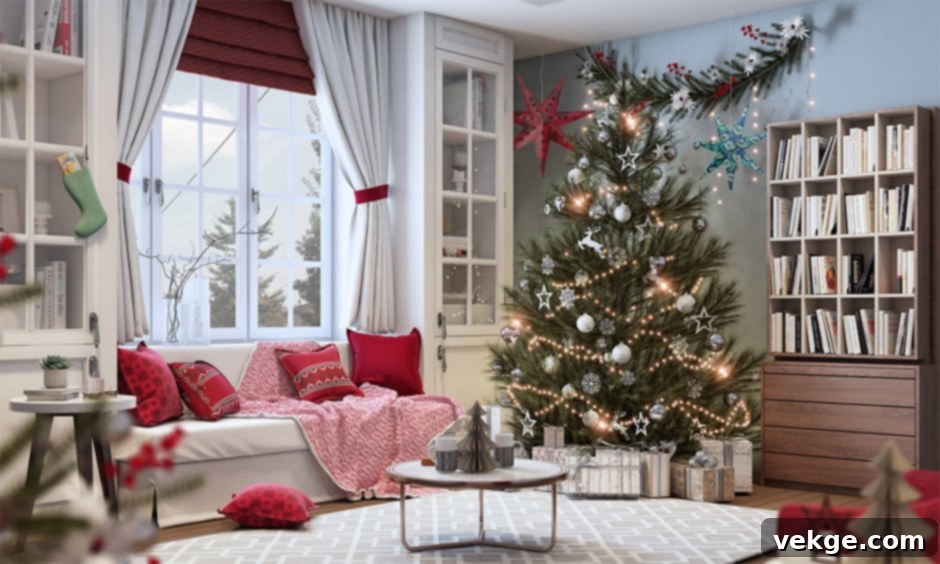
The majestic Christmas tree stands as the undisputed centerpiece of holiday decorations, a tradition cherished in homes across the globe. Far more than just a beautiful display, this evergreen fir is laden with deep historical and spiritual significance. Its roots trace back to ancient pagan rituals, where evergreens symbolized life and rebirth during the darkest days of winter, offering a promise of spring’s return. Early Christians later adopted this practice, transforming the evergreen into a powerful symbol of everlasting life and God’s enduring love.
Adorned with lights, baubles, and garlands, the Christmas tree represents the tree of life, celebrating the birth of Jesus and the hope he brings. The act of decorating the tree itself is a beloved family tradition, fostering togetherness and creating lasting memories. Each branch, each needle, points towards a continuous connection with the divine, making the Christmas tree not just an ornament, but a profound expression of faith and renewal that brightens homes and hearts throughout the festive season.
2. The Lucky Shamrock: A Touch of Irish Charm and Trinity Symbolism
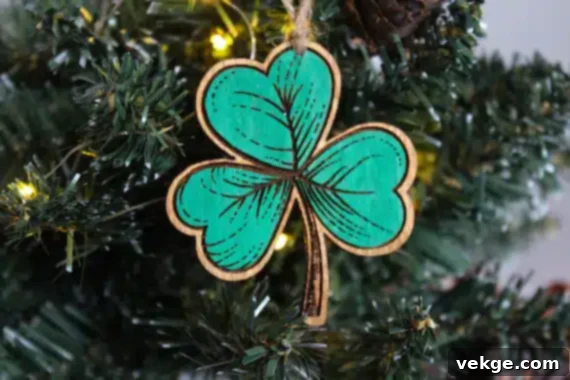
While primarily recognized for its strong association with St. Patrick’s Day and Irish culture, the shamrock occasionally finds its way into Christmas decor as a symbol of good fortune and spiritual depth. This distinctive three-leaf clover is famously believed to have been used by Saint Patrick to explain the Holy Trinity: God the Father, God the Son, and the Holy Spirit, illustrating how three distinct entities can exist as one. The stem of the leaf beautifully represents their unity, while the leaves themselves represent their individual aspects.
Beyond its Christian symbolism, the shamrock, and its rarer cousin, the four-leaf clover, are universally recognized as powerful talismans of luck. Incorporating a shamrock ornament onto your Christmas tree can be a charming way to invite blessings, good health, and prosperity into your home for the coming year. It serves as a gentle reminder of faith and the serendipitous moments that bring joy, adding a unique cultural layer to your festive ensemble.
3. The Playful Christmas Pickle: A Festive Hunt for Good Fortune

The Christmas pickle ornament introduces a delightful game into holiday traditions, especially for families with children. This unique, usually green, glass ornament is typically the very last decoration to be placed on the Christmas tree, cleverly hidden deep within its branches on Christmas Eve. The playful custom dictates that on Christmas morning, the first person to spot the hidden pickle receives an extra present and is said to enjoy a year filled with good luck and blessings.
While often attributed to a classic German tradition, the true origins of the Christmas pickle are somewhat debated, with many believing it to be a more recent American marketing invention. Regardless of its exact historical roots, the charm of the Christmas pickle lies in the element of surprise and anticipation it brings to the festive season. It encourages close observation, fosters a sense of lighthearted competition, and adds an extra layer of magic and cheer to the already joyful Christmas morning, making it a beloved annual ritual for many.
4. The Delightful Ladybug: A Talisman of Luck and Guardian Angels

Among the myriad of charming Christmas ornaments, the ladybug holds a special place, often regarded as a potent talisman of luck and a symbol of protection. Across various cultures, this tiny, spotted insect is associated with positive omens and blessings. A popular belief suggests that if a ladybug lands on you, you’ll experience as many years of good fortune as the number of spots on its back, or that it signifies an impending wish coming true.
Beyond mere luck, the ladybug is also seen as a representation of guardian angels and divine protection, bringing a sense of peace and security during the holidays. Its vibrant red and black colors often symbolize love and passion, making it a cheerful addition to any Christmas tree. Incorporating a delightful ladybug ornament into your festive decor serves as a gentle reminder to embrace optimism, cherish blessings, and trust in the benevolent forces that watch over us, imbuing your home with a touch of whimsical positivity.
5. Radiant Angels: Messengers of Hope and Spiritual Connection
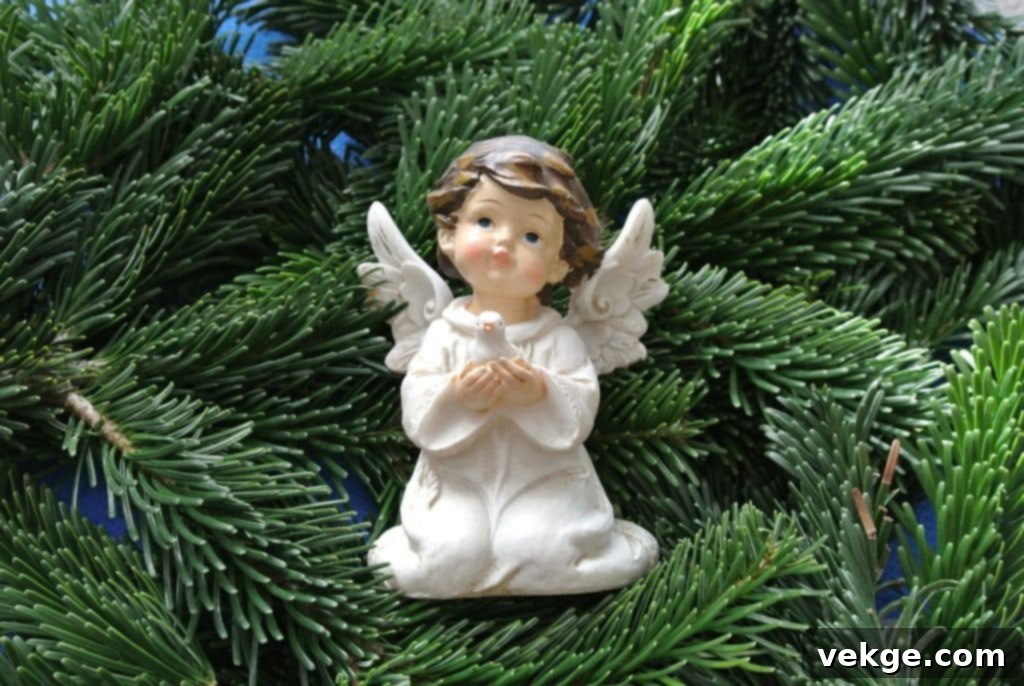
Angels are indispensable figures in the tapestry of Christmas celebrations, embodying purity, hope, and divine messages. These celestial beings, often depicted with wings and halos, are revered as spiritual entities that serve as God’s messengers, carrying out his will and bringing tidings of great joy. Their presence is central to the Christmas narrative, most notably in the Annunciation to Mary and the glorious proclamation to the shepherds at Jesus’ birth, where they sang “Glory to God in the highest.”
Incorporating angel ornaments into your Christmas decor is a profound way to honor the spiritual essence of the season. Whether perched atop the Christmas tree as a guiding star or nestled among branches, angels symbolize protection, guidance, and a deeper connection to the divine. They inspire feelings of peace and wonder, reminding us of the miracle of Christmas and the benevolent presence of heavenly hosts. As their images grace our homes and their stories fill our carols, angels truly enrich the spiritual fabric of the holiday season.
6. Sparkling Stars and Melodious Bells: Guiding Light and Joyful Proclamations
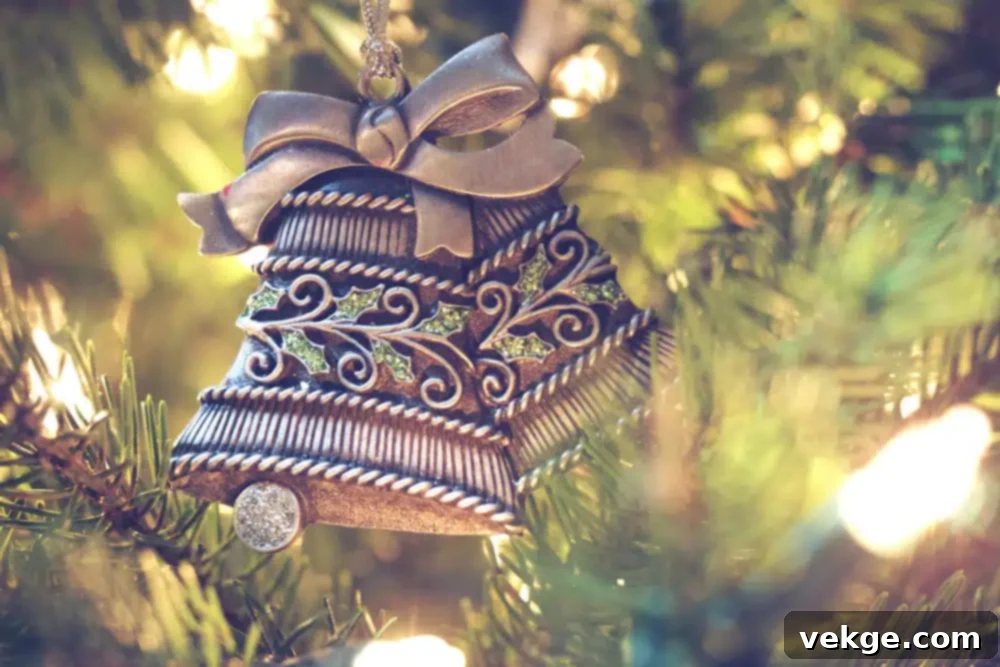
The star and bell ornaments are iconic symbols of Christmas, each carrying profound meaning and a rich history. The sparkling star, most famously represented by the Star of Bethlehem, symbolizes the guiding light that led the Three Wise Men to the birthplace of baby Jesus. Placed proudly at the very top of the Christmas tree, it signifies hope, divine guidance, and the revelation of Christ to the world. This tradition often involves the most esteemed family member placing the star, marking it as a culmination of the decorating process and a beacon of faith for the year ahead.
Complementing the star are the melodious bells, whose resonant sounds have long been associated with joy, celebration, and the spreading of good news. Historically, bells were rung to announce significant events, and at Christmas, they are said to echo the angelic hymns that heralded the birth of Jesus. Beyond this, bells were also believed to ward off evil spirits, purifying the air and inviting positivity into the home. Together, stars and bells create a harmonious blend of spiritual symbolism and festive cheer, illuminating our path and filling our homes with the joyful sounds of Christmas.
7. Multi-Faceted Christmas Baubles: Echoes of Nature and Festive Brilliance
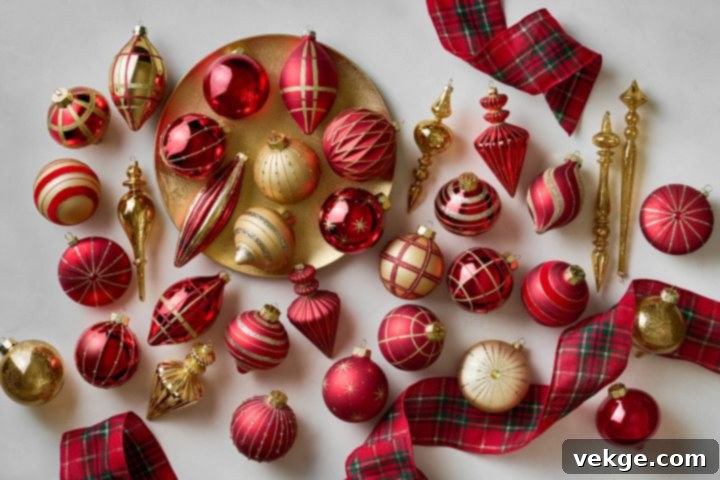
Christmas baubles, with their dazzling array of sparkling surfaces, intricate shapes, and vibrant hues, are perhaps the most recognizable and versatile of all holiday ornaments. Their history is deeply intertwined with the evolution of Christmas tree decoration. Originally, people adorned their trees with natural elements like apples, nuts, and berries, which symbolized the bounty of nature and served as a reminder of spring’s eventual return even in the depths of winter. These humble beginnings laid the foundation for the more elaborate ornaments we see today.
The tradition of glass baubles as we know them largely originated in 19th-century Germany, where skilled glassblowers began crafting delicate, reflective spheres. These early glass ornaments captured and magnified the light, adding an ethereal glow to the festive tree. Today, baubles come in an endless variety of materials, designs, and themes, each contributing to the tree’s overall splendor. Beyond their aesthetic appeal, they symbolize the preciousness of life, the kaleidoscope of human experience, and the joy of shared celebrations. Along with ribbons and buntings, baubles transform a simple evergreen into a glittering tapestry of holiday cheer.
8. A Bunch of Carrots: Nurturing Generosity for Santa’s Reindeer
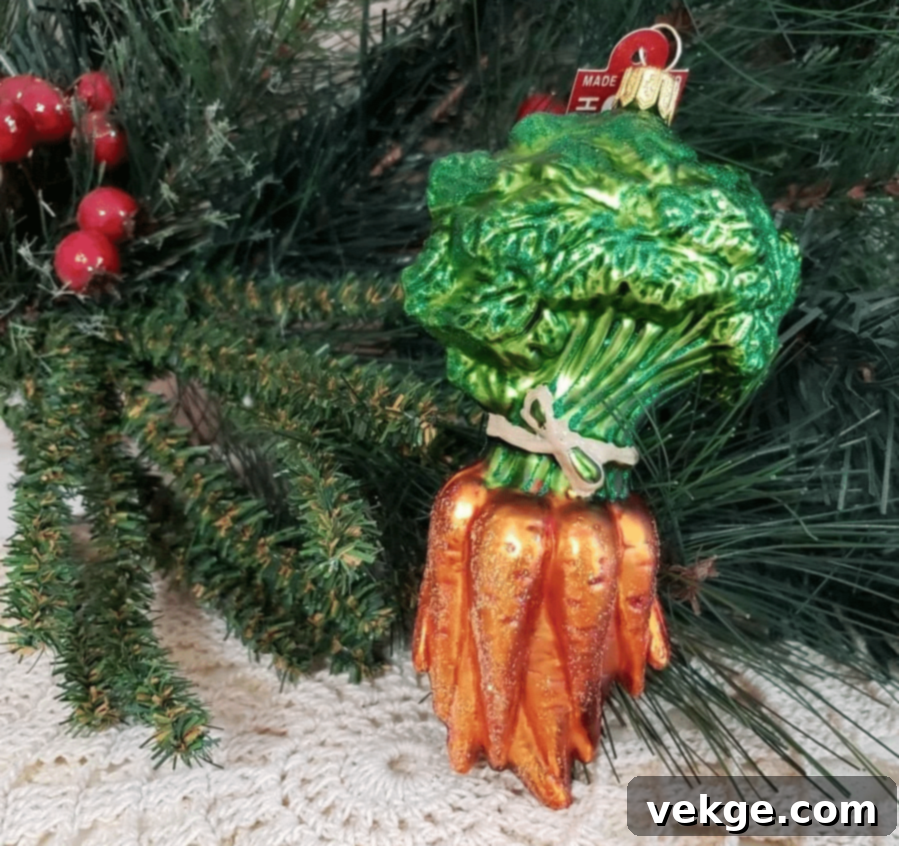
While not as universally known as other ornaments, the inclusion of a carrot or a bunch of carrots in Christmas decor carries a charming and endearing tale, particularly popular in European traditions. The most widely accepted belief connects this humble vegetable directly to Santa Claus and his trusty team of reindeer. Children would traditionally leave carrots in their stockings or alongside the fireplace, not for Santa himself, but as a nourishing treat for his hardworking reindeer, ensuring they had enough energy to complete their epic journey around the world.
This sweet custom symbolizes generosity, thoughtfulness, and the spirit of giving, even to the unseen helpers of Christmas. It teaches children about caring for others and the joy of making a small, kind gesture. While the alternative theory about young brides is less common in mainstream Christmas lore, the primary association of carrots with Santa’s reindeer firmly establishes it as a symbol of nurturing and provision during the festive season, adding a quaint, rustic touch to your holiday arrangements and inspiring acts of kindness.
9. The Enigmatic Golden Seashell: A Symbol of Renewal and Good Fortune

The golden seashell, while perhaps not a fixture in traditional Western Christmas lore, has gracefully carved out its own unique niche in modern holiday decor, appreciated for its ethereal beauty and profound symbolic meanings. Seashells, in general, are ancient symbols steeped in myth and folklore, often associated with the sea goddesses and the origins of life itself. The golden hue further enhances its significance, linking it to prosperity, divine light, and enduring value.
Specifically, a golden seashell is believed to symbolize birth and rebirth, mirroring the journey of life from the ocean’s depths. It also represents love, the ebb and flow of emotions, and the promise of resurrection and new beginnings. As a symbol of good luck, it invites positive energy and abundance into the home. For those who prefer not to hang it directly on the Christmas tree, a golden seashell makes a stunning focal point on a mantelpiece, or a delicate addition to a festive wreath, lending an unexpected touch of coastal elegance and timeless symbolism to your holiday tableau.
10. The Humble Golden Acorn: A Symbol of Potential, Strength, and New Beginnings
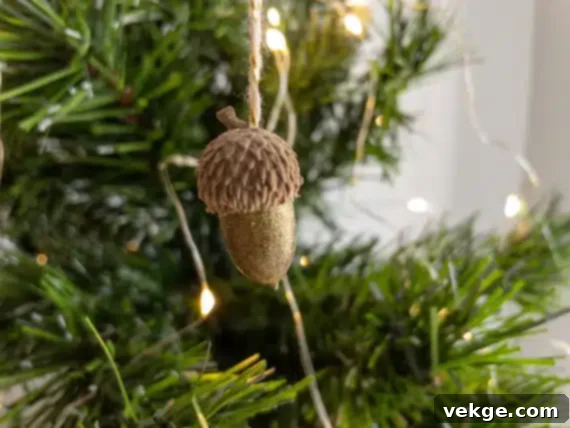
The humble golden acorn, often overlooked amidst flashier ornaments, carries a profound and timeless message encapsulated in the adage, “From little acorns come mighty oaks.” This small but mighty seed represents far more than just its origin; it is a potent symbol of birth, growth, and the continuous cycle of life. It reminds us that even the most unassuming beginnings can lead to magnificent outcomes, embodying immense potential and future greatness.
Historically, acorns have been revered across various cultures, particularly in Celtic and Norse traditions, where oak trees were considered sacred and symbols of strength, longevity, and resilience. Bringing an acorn ornament into your Christmas decor can serve as a powerful reminder of inner strength, the promise of new beginnings, and the potential within each of us to grow and achieve great things. It inspires hope and confidence, making it a meaningful addition that encourages reflection on personal development and the unfolding journey of life during the contemplative holiday season.
11. Loaded Christmas Stockings: A Tradition of Surprise, Generosity, and Anticipation
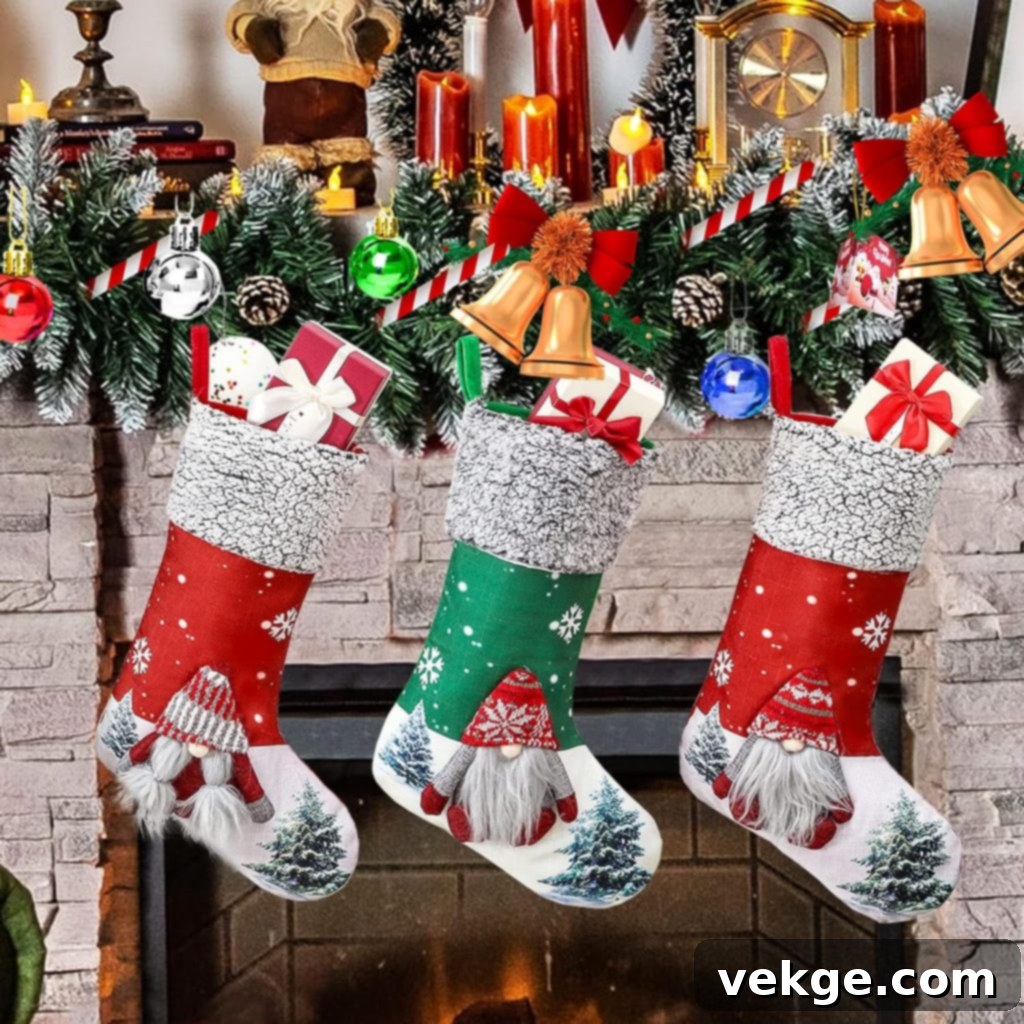
Christmas stockings are synonymous with the excitement and wonder of the holiday season, a cherished tradition that fills homes with anticipation. Usually hung with care along the mantelpiece, by a window, or at the foot of a child’s bed, these festive pouches are eagerly awaited. Their origins trace back to the legend of Saint Nicholas, who is said to have secretly left gold coins in the stockings of impoverished girls, saving them from destitution. This act of quiet generosity evolved into the beloved custom we know today.
On Christmas Eve, adults lovingly fill these stockings with an assortment of small treasures: candies, miniature toys, trinkets, fruit, and practical small gifts. The joy on Christmas morning, as children discover their hidden surprises, is an indelible part of the holiday experience. Stockings symbolize the spirit of giving, the warmth of family, and the magic of receiving unexpected delights. They are not just decorative items but vessels of joy, carrying wishes and blessings into the new year, making the Christmas morning reveal a moment of pure, unadulterated happiness for all.
12. The Bountiful Wreath: A Welcoming Circle of Eternal Life and Festive Cheer

The Christmas wreath is an indispensable element of holiday decor, symbolizing far more than just festive embellishment. Its perfect circular shape represents eternity, wholeness, and the never-ending cycle of life, love, and the changing seasons. Traditionally crafted from evergreens like holly, fir, and pine, the vibrant green leaves beautifully signify life’s continuity and resilience, even amidst the frosty dormancy of winter. Hung prominently on front doors, wreaths serve as a warm, inviting welcome to guests, embodying hospitality and the spirit of togetherness.
Beyond its welcoming gesture, the wreath is also a powerful symbol of faith and hope, particularly with the Advent wreath marking the anticipation of Christ’s birth. While large wreaths adorn entryways, smaller versions can grace walls, windows, or even be integrated into table centerpieces. Creative decorators often enhance their wreaths with additional ornaments – from festive baubles and miniature carrots to symbolic acorns – to create a richer, more personalized display. This practice not only makes the wreath more visually appealing but also allows it to incorporate a wider array of meaningful symbols, transforming it into a bountiful tapestry of Christmas joy and tradition.
Are you interested in learning more about Christmas decor? Check out our previous blog that holistically covered white christmas decor ideas.
Conclusion: Embracing the Deeper Magic of Christmas Decorations
As we’ve explored, Christmas is a season rich with tradition, community, and profound symbolism. Beyond the glittering lights and festive cheer, each ornament we place, from the towering Christmas tree to the smallest hidden pickle, carries a story, a wish, or a historical echo. These decorations are not merely aesthetic enhancements; they are powerful expressions of our collective hopes, cultural heritage, and spiritual beliefs, designed to infuse our homes with well-being, good fortune, and enduring positivity.
Whether it’s the evergreen tree’s promise of eternal life, the shamrock’s nod to the Holy Trinity, the ladybug’s whisper of luck, or the acorn’s testament to hidden potential, every piece contributes to the rich tapestry of the holiday. By understanding these deeper meanings, we transform the act of decorating from a simple task into a mindful ritual, connecting us to generations past and reinforcing the values of love, hope, and generosity that define Christmas.
Adorning your home with these meaningful trinkets is a beautiful way to honor timeless cultural traditions and remind everyone about the enduring beauty of shared beliefs. This year, as you hang your favorite ornaments, take a moment to appreciate the stories they tell and the blessings they represent. May your holiday season be filled with joy, meaning, and the magic that these cherished symbols bring.
For more inspiring content and festive ideas, be sure to follow us and share your own cherished Christmas ornament meanings in the comments section below!
